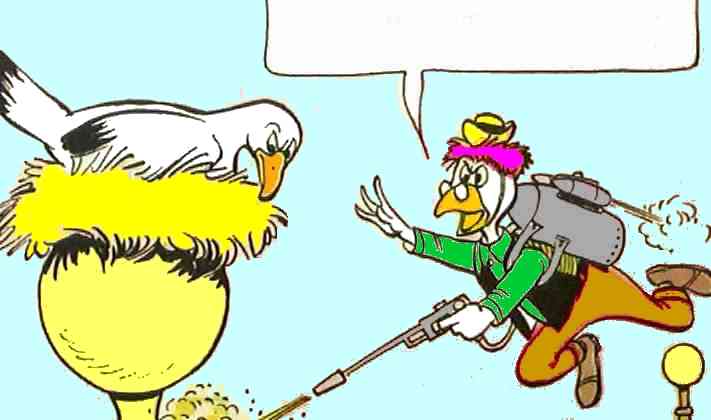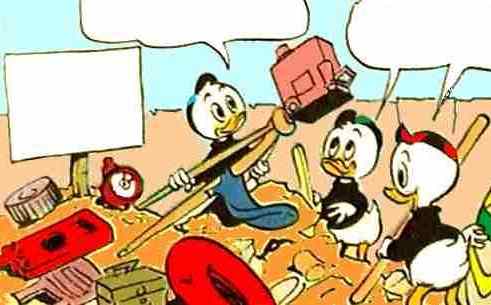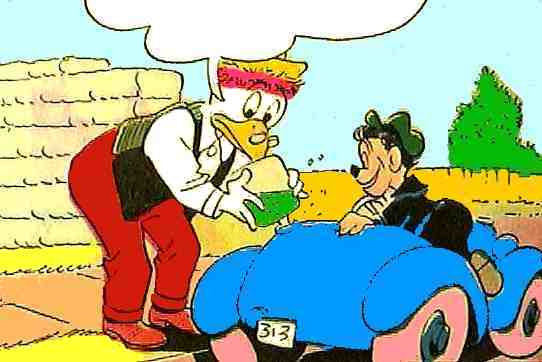

Barks' unparalleled imagination has inspired many people in their respective fields. Artists, inventors and even filmmakers are among those who acknowledge that they have benefited from Barks' stories in different ways.
| KENO DON ROSA | |||
|
Many of today's comic book artists follow in Barks' footsteps. One of the best known is the American Keno Don Rosa whose stories often use ideas, plot devices and characters created by his idol - Barks. |
|||
Rosa has written many sequels to Barks' stories. This is the sequel to Barks' perhaps most popular adventure story. |
|||
Rosa wrote a string of stories in which he told the history of Scrooge's past. He occasionally copied some of Barks' original panels into his artwork. |
|||
In many of Rosa's stories there are clear references to Barks' stories, although many of the references may not be recognized by the casual reader. In this panel Rosa placed no fewer than 5 characters taken from well-known stories. From left to right you may recognize: The Maharajah of Howduyustan (WDCS138), Azure Blue (FC0408), a representative from Brutopia (U$17), Chisel McSue (FC0495), and Longhorn Tallgrass (U$23). |
|||
| WESTERN | ||
|
From 1946 to 1949 the Whitman Publishing Company (Western) published 5 books based on some of Barks' stories. The books would have a Barks drawing on one page with accompanying text written by unknown writers on the opposite page. |
||
 Donald Duck and Ghost Morgan's Treasure A version of the story from FC0009 Donald Duck finds Pirate Gold. |
 Donald Duck and the Green Serpent A version of the story from FC0108 The Terror of the River. |
 Donald Duck in Volcano Valley A version of the story from FC0147 Volcano Valley. |
| KARL KRØYER | |
 The cargo ship slowly surfacing... |
WDCS104 |
|
The date: September 14, 1964. The scene: Kuwait City's harbour. The incident: The 2,000 tons cargo ship Al-Kuwait carrying almost 6,000 live sheep in its hull capsized and sunk in the harbour. Since the city pumped their drinking water from the harbour, fast action was needed so that the rotting carcasses would not render the water poisonous. Because of the massive number of sheep, the depth of the harbour and the murky water, none of the usual methods of raising a sunken ship could be considered. A cry for help went out all over the world, and it was heard by the Danish manufacturer, engineer and inventor Karl Krøyer, who rushed to the scene. He realized that the only solution would be to raise the ship in one piece and then transport it to a place where it could be emptied safely. A novel idea came to mind: Krøyer remembered reading a Barks story in the Danish Donald Duck magazine describing how Donald and his nephews were able to raise a sunken yacht by pumping scores of air-filled ping pong balls into the wreckage - thereby forcing it to the surface (WDCS104). Krøyer realized the same principle could be used to raise the sunken freighter. He knew that normal ping pong balls would not be able to do the trick in real life, so he invented special pearl-sized balls made of a special composition of polystyrene foam that was baked into air-filled bubbles. These balls were able to occupy 40 times their volume thus giving them enormous lifting power in water. Millions of small balls were formed and baked right on the scene, and then continuously pumped into the freighter's hull. First between the two highest decks, then into the lower holds. It took 150 tons of the ultra-light foam balls to raise the cargo ship in one piece, whereupon it was immediately towed away to be emptied. Aftermath: After this indisputable success Krøyer went on to raise a Danish coaster which had sunk in the harbour of Sukkertoppen (now Maniitsoq) in Greenland. He then filed for a patent for his invention. The application was denied. Why? Because the invention was not new! It had already been published on a previous occasion - in the comic book WDCS104... |
|
| GEORGE LUCAS / STEVEN SPIELBERG | ||
 Raiders of the Lost Ark |
U$07 |
U$26 |
|
The world-famous filmmakers George Lucas and Steven Spielberg have been dedicated fans of Carl Barks and his comics since childhood, and they have used some of Barks' ideas in a number of their films. My greatest source of enjoyment in Carl Barks' comics is in the imagination of his stories. They're so full of crazy ideas - unique and special, Lucas once said. In the Indiana Jones trilogy Raiders of the Lost Ark (1981), The Temple of Doom (1984), and The Last Crusade (1989) the filmmakers used several booby traps from Barks' stories U$07 'The Seven Cities of Cibola' and U$26 'The Prize of Pizarro'. Examples are flying darts, a decapitating blade, a guardian idol, a huge boulder, and a tunnel flooded with a torrent of gushing water. Some may argue that Spielberg's film Batteries Not Included (1987) has clear references to U$65 Micro-Ducks from Outer Space in which Scrooge has dealings with tiny aliens. In Spielberg's film, the tenants in an apartment building are being forced to move from their homes by developers. Tiny aliens come to the rescue and use their extraterrestrial abilities to defeat the bad guys. |
||
| FOLLOW UPS | ||
| Barks has given many people ideas for inventions that today are fairly common. Here are some examples from Gyro Gearloose's workshop - and remember: Barks came first... | ||
U$19 Originally: Inflatable bubble house. Today: Used nowadays for movable sports halls, churches and more. |
 U$38 Originally: Tree growth injections. Today: Arborists inject fertilizers or pesticides directly into the trunks of trees. |
 WDCS201 Originally: A very powerful dye. Today: Potent dye that only needs to be used extremely sparingly. |
U$14 Originally: A foam stone that can withstand impacts. Today: Several modern polystyrene compositions have this durability. |
U$24 Originally: A cyclone detector. Today: Detectors of cyclones and earthquakes are installed in many vulnerable areas. |
 U$46 Originally: A rocket belt that can transport people in the air. Today: One-man rocket apparatus. First seen publicly at the 1984 Olympics in Los Angeles, USA. |
 SF Jungle Hi-Jinks Originally: Instant developing film camera. Today: Videotape camera. |
 U$14 Originally: Super-Speed Gasoline. Today: Additives have greatly improved the performance of petrol. |
WDCS183 Originally: Custard gun that does no harm. Today: Paint gun. |
| http://www.cbarks.dk/THEBORROWERS.htm | Date 2005-04-19 |